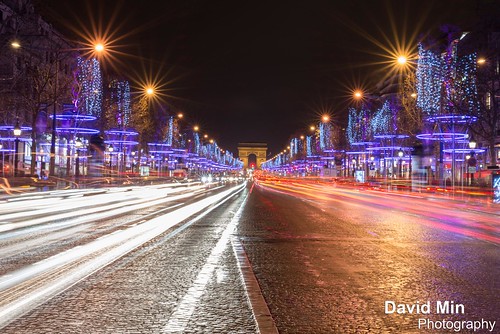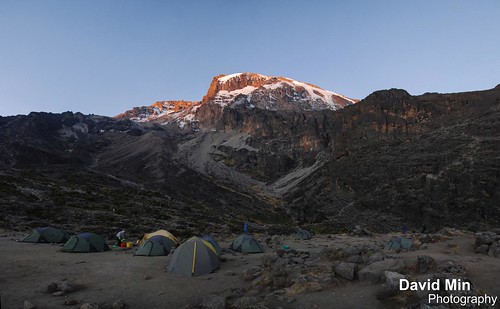Every year, for Christmas and the New Year, the avenue des Champs-Elysées is decorated with lights and stunning decorations. Star bursts, sparkling garlands, rings of light, shimmering curtain effect … bring the 200 trees along the world’s most beautiful avenue to life … A festive landscape for a magical Christmas!
Don't forget to visit the Christmas market in the area while you're at it, to grab some mulled wine and find some original Parisian Christmas gifts.
Sunday, December 23, 2012
Paris, France - Merry Christmas @Champs-Elysées
Saturday, December 15, 2012
Sunset @Mount Kilimanjaro, Tanzania
Kilimanjaro, with its three volcanic cones, Kibo, Mawenzi, and Shira, is a dormant volcano in Kilimanjaro National Park, Tanzania and the highest mountain in Africa at 5,895 metres above sea level (the Uhuru Peak/Kibo Peak).
There are six official trekking routes by which to climb Mt Kilimanjaro, namely: Marangu, Rongai, Lemosho, Shira, Umbwe and Machame. Of all the routes, Machame is by far the most scenic albeit steeper route up the mountain, which can be done in six or seven days. The Rongai is the easiest and least scenic of all camping routes with the most difficult summit night and the Marangu is also relatively easy, but accommodation is in shared huts with all other climbers. As a result, this route tends to be very busy, and ascent and descent routes are the same.
People who wish to trek to the summit of Kilimanjaro are advised to undertake appropriate research and ensure that they are both properly equipped and physically capable. Though the climb is technically not as challenging as when climbing the high peaks of the Himalayas or Andes, the high elevation, low temperature, and occasional high winds make this a difficult and dangerous trek. Acclimatisation is essential, and even then most experienced trekkers suffer some degree of altitude sickness.
Tuesday, December 11, 2012
Mont Blanc Climbing HD (July 12nd, 2012)
Sunday, December 9, 2012
Pokhara, Nepal - Annapurna Sanctuary
The Annapurna Sanctuary is high glacial basin lying forty kilometers directly north of Pokhara. This oval-shaped plateau sits at an altitude of over 4000 meters, and is surrounded by a ring of mountains, the Annapurna range, most of which are over 7000 meters. With the only entrance a narrow pass between the peaks of Hiunchuli and Machapuchare, where run-off from glaciers drain into Modi Khola River, the Sanctuary was not penetrated by outsiders until 1956. Because of high mountains on all sides, the Annapurna Sanctuary receives only 7 hours of sunlight a day at the height of summer. The unique combination of heights and depths in the Annapurna Sanctuary give rise to an extraordinary variety of ecosystems. The south-facing slope are “covered in dense tropical jungles of rhododendron and bamboo”, while the north-facing slopes, in the rain shadow, have “a drier colder climate similar to that of the near-by Tibetan Plateau.”
The entire sanctuary was held as sacred to the Gurung people, one of the many native people to inhabit the area. They believed it was the repository of gold and various treasures left by the Nāgas, the serpent-gods known in India. The sanctuary was believed to be the home of several deities, from Hinduism and Buddhism as well the older animistic gods. The peak of Machapuchare at the entrance was believed to be the home of the god Shiva, and the daily plumes of snow were thought the smoke of his divine incense. Until recently, the local Gurang people forbade anyone from bringing eggs or meat into the Annapurna Sanctuary, and women and untouchables were prohibited from going there as well.
In recent years, the number of trekkers to the Sanctuary has increased substantially, in part because the Sanctuary forms the base of one of the major routes to the peaks of the Annapurna range. The Annapurna Sanctuary is now part of the Annapurna Conservation Area Project, which places restrictions on number of outside travelers, gathering of firewood, and domestic animal grazing.
Wednesday, December 5, 2012
Ngorongoro Crater, Tanzania
The Ngorongoro Conservation Area is a conservation area and a UNESCO World Heritage Site situated 180 km west of Arusha in the Crater Highlands area of Tanzania. The Ngorongoro Crater, a large volcanic caldera, lies within the area.
A population of approximately 25,000 large animals, largely ungulates along with reputedly the highest density of mammalian predators in Africa, lives in the crater. Large animals in the crater include the black rhinoceros, the local population of which declined from about 108 in 1964-66 to between 11-14 in 1995, and the hippopotamus, which is very uncommon in the area. There also are many other ungulates: the wildebeest (7,000 estimated in 1994), the zebra (4,000), the eland, and Grant's and Thompson's gazelles (3,000).
The crater has the densest known population of lions, numbering 62 in 2001. On the crater rim are leopards, elephants – numbering 42 in 1987 but only 29 in 1992 – mountain reedbuck, and buffalo (4,000 in 1994). In the middle of the crater there is a large lake inhabited by hundreds of flamingoes and from a distance, they appear as a pink border of the lake.
Aside from herds of zebra, gazelle, and wildebeest, the crater is home to the "big five" of rhinoceros, lion, leopard, elephant, and buffalo. The crater plays host to almost every individual species of wildlife in East Africa, with an estimated 25 000 animals within the crater.
Sunday, December 2, 2012
Annapurna, Nepal - Mount Machapuchare
Machapuchare or Machhapuchhre (6 997m) meaning "Fish Tail" in English, is a mountain in the Annapurna Himalaya of north central Nepal. It is revered by the local population as particularly sacred to the god Shiva, and hence is off limits to climbing.
Machhapuchhre is at the end of a long spur ridge, coming south out of the main backbone of the Annapurna Himal, that forms the eastern boundary of the Annapurna Sanctuary. The Sanctuary is a favorite trekking destination, and the site of the base camps for the South Face of Annapurna and for numerous smaller objectives.
Due to its southern position in the range, and the particularly low terrain that lies south of the Annapurna Himal, Machapuchare commands tremendous vertical relief in a short horizontal distance. This, combined with its steep, pointed profile, make it a particularly striking peak, despite a lower elevation than some of its neighbors. Its double summit resembles the tail of a fish, hence the name meaning "Fish's Tail" in Nepali language It is also nicknamed the "Matterhorn of Nepal".
Machapuchare has never been climbed to its summit. The only attempt was in 1957 by a British team led by Jimmy Roberts. Climbers Wilfrid Noyce and A. D. M. Cox climbed to within 50 m of the summit via the north ridge, but did not complete the ascent; they had promised not to set foot on the actual summit. Since then, the mountain has been declared sacred, and it is now forbidden to climbers.




